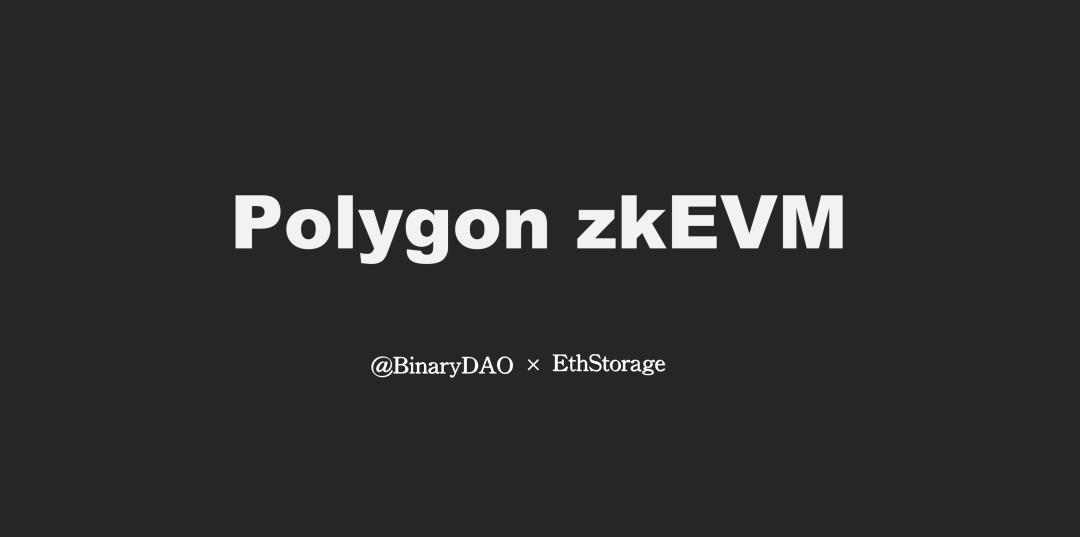Interpreting Nostr: Two Keys to Unlock a New Paradigm of Decentralized Social Media
Author: EvieEvieXia, Binary DAO
Research Guide:
The Nostr protocol is an extremely minimalist social protocol that does not rely on any centralized servers. Client information publishing and transmission are accomplished by non-communicating relays, making the publication and transmission of information resistant to censorship. Any user can create a public-private key pair without relying on a specific social account or domain name, making it easier for users to join and freeing them from the constraints of third-party servers.
Since Twitter founder Jack Dorsey announced the launch of the Nostr-based application Damus on February 1, 2023, the number of protocol users has surged. As of February 5, 2023, the number of public keys reached over 500,000. The Nostr ecosystem is also continuously expanding; in addition to being hailed as the decentralized Twitter, Damus, there are communication tools like Anigma, text-sharing tools like Sendtr, and online chess mini-games like Jeste, among others.
Compared to other social protocols, the core of Nostr, which is not based on blockchain, lies in its simplicity and high interoperability, making it possible to build applications on a large scale. Developers can quickly reach a consensus on open standards and rapidly develop iterations on client programs, thereby placing all complexity on the client side. As long as the foundation is solid, there is no fear of a lack of applications.
Nostr's developer fiatjaf is also a developer of Bitcoin and the Lightning Network, so Nostr natively supports the Lightning Network (internet applications + payment systems). The Lightning Network is extremely fast and powerful, capable of supporting high-concurrency applications, providing strong support for applications on Nostr.
Whether to introduce an incentive layer in the construction of the Nostr protocol relay network is a dilemma. If the infrastructure is built on a fragile "voluntarism" basis, it will be difficult to grow into a strong social network; however, if there are incentives, most of the incentives will gradually be controlled by a few people, making it impossible to form effective incentives and susceptible to attacks.
Relays lack incentives and do not have enough motivation to store user data, thus there is a possibility of relays actively or passively deleting data. In the future, Nostr may provide incentives for storage functions, ensuring decentralization and ease of use while making data more accessible.
The Nostr protocol provides building blocks for decentralized social networking. Perhaps what we need at this stage is not a replica of a Web2 application based on Nostr, but a finely designed infrastructure, allowing hidden super developers to build products that exceed imagination and have a strong Bitcoin core. Decentralized social networking is just beginning.
I. The Creation Concept of the Nostr Protocol
1. Basic Information
Nostr stands for Notes and Other Stuff Transmitted by Relays, and it is a decentralized social network open-source protocol that started in 2020. The project founder fiatjaf is also a developer of Bitcoin and the Lightning Network. Currently, the project has not publicly raised funds, and Twitter founder Jack Dorsey has donated 14 BTC to the project.
2. Operating Principle
The Nostr protocol consists of two parts: a client and a relay. The client is used for signing and verifying information and is run by users. The relay can capture, store any information linked to it from clients, and forward it to other clients. Anyone can run a relay, but relays do not communicate with each other, which is fundamentally different from blockchain nodes.
Additionally, clients allow users to connect with any number of relays they want, and users can choose whether they want to read or write information from the relays they are connected to. This means that we can connect to a relay to retrieve content but choose not to publish events there, or vice versa.
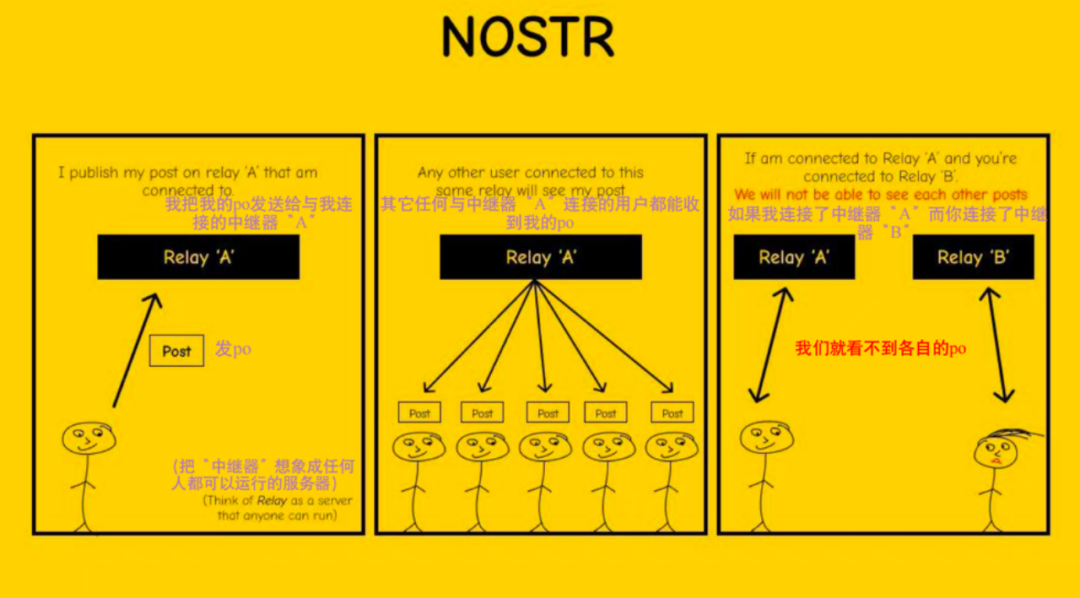
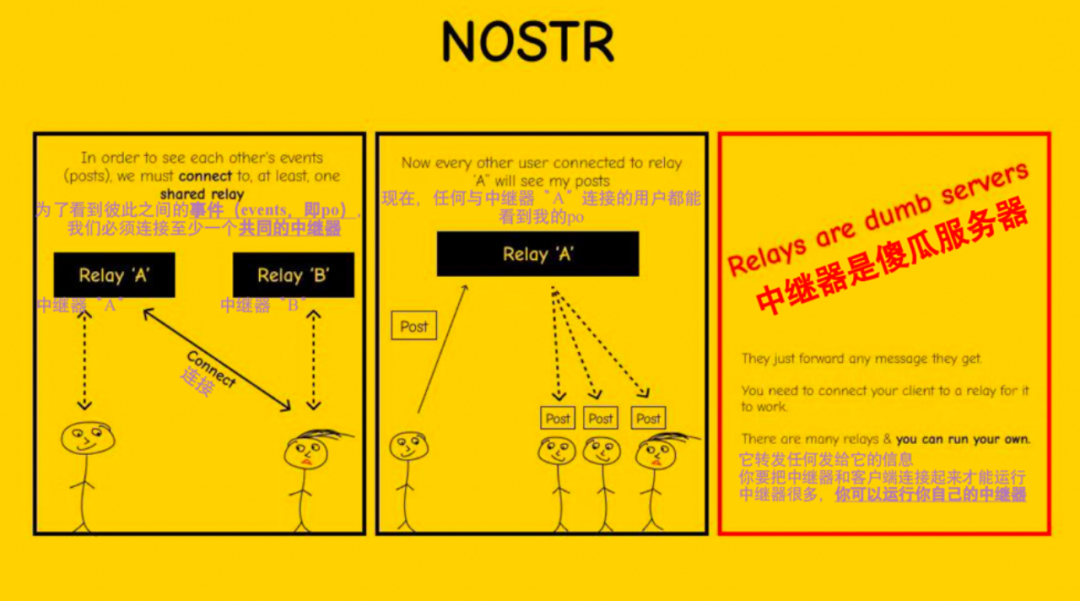
Image Source: @coderjourney1
3. Protocol Features
a) Simple and Easy Registration: Any user can create a pair of public and private keys without registering through a domain name or social account. Nostr's signing and verification algorithm is not the commonly used ECDSA but the Schnorr signature algorithm, which means that if a user already has a Bitcoin or Ethereum private key, it can be used on the Nostr network. However, due to different encoding formats, the display of private keys may vary across different networks, requiring a conversion.
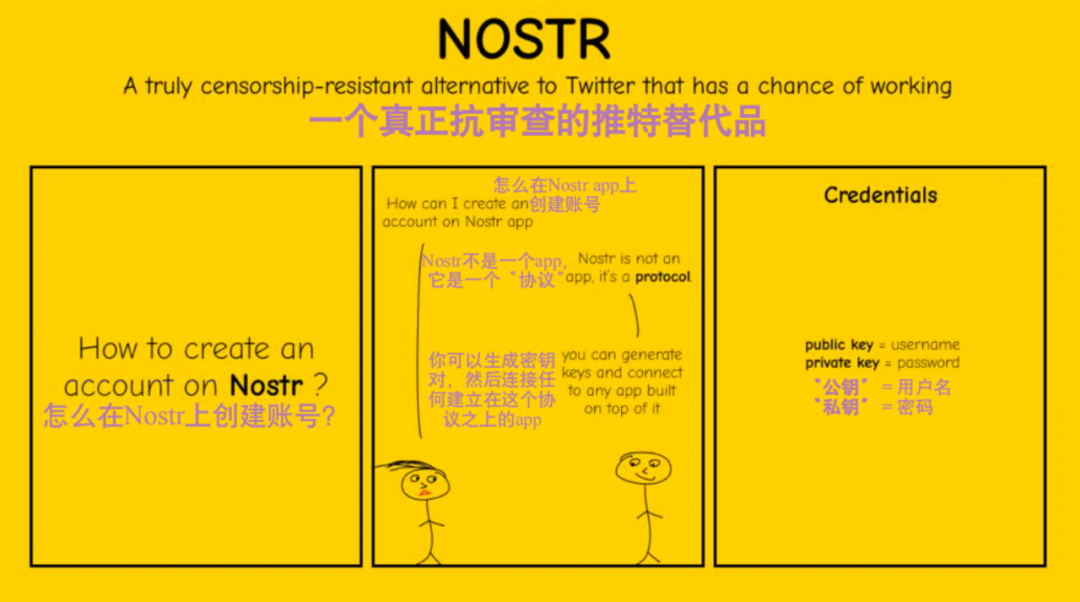
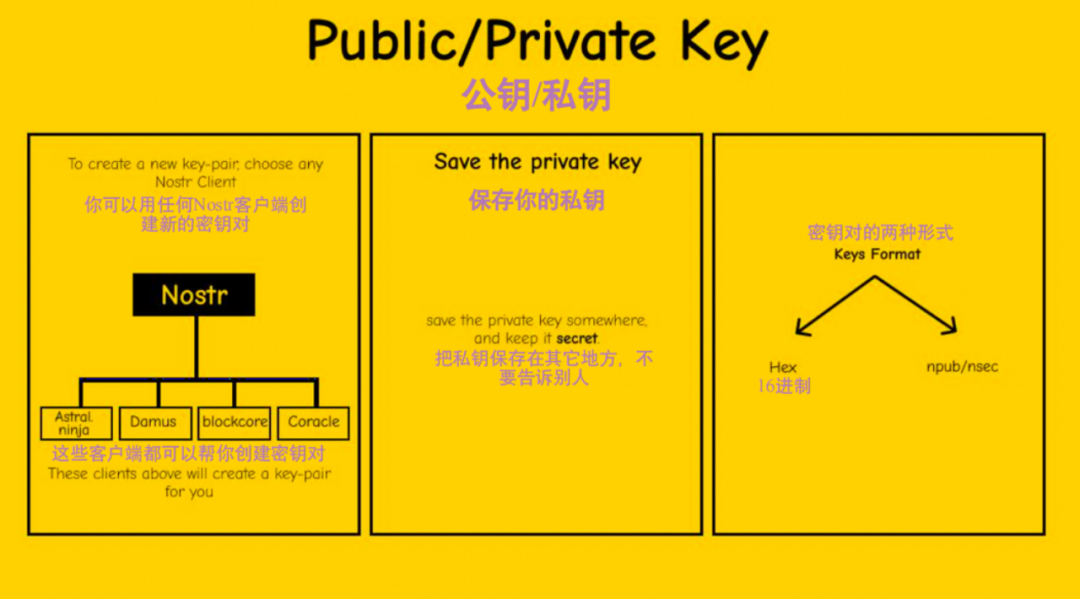
Image Source: @coderjourney1
b) Decentralized Information Transmission and Storage: It does not rely on any trusted centralized servers, and client-published information can be stored on multiple relays, thus reducing dependence on a single relay and enhancing recovery speed.
c) Reduced Trust Risk: Messages have public key identifiers, and message verification is completed by the client. Relays are only responsible for storage and transmission, so users do not need to trust the relays, further reducing the trust risk associated with signing through Web3 wallets.
d) Handling Spam: If accounts cannot be deleted or banned in the Nostr network, how can we combat undesirable information? Nostr relays can require users to pay for publishing or use other forms of identity verification, associating these internally with public keys to combat spam. If a relay is used as a carrier for spam, it will likely be discarded by users, and clients can continue to receive updates from other relays.
e) Integration with the Lightning Network: Nostr's developer fiatjaf is also a developer of Bitcoin and the Lightning Network, so Nostr natively supports the Lightning Network. The Lightning Network is very fast and powerful, capable of supporting high-concurrency applications on Nostr. The Nostr-based client Damus has built-in Bitcoin Lightning Network functionality, allowing direct payments through third-party Lightning Network wallets. On February 3, 2023, Damus announced that it would randomly distribute small amounts of Bitcoin to users through the Bitcoin Lightning Network.
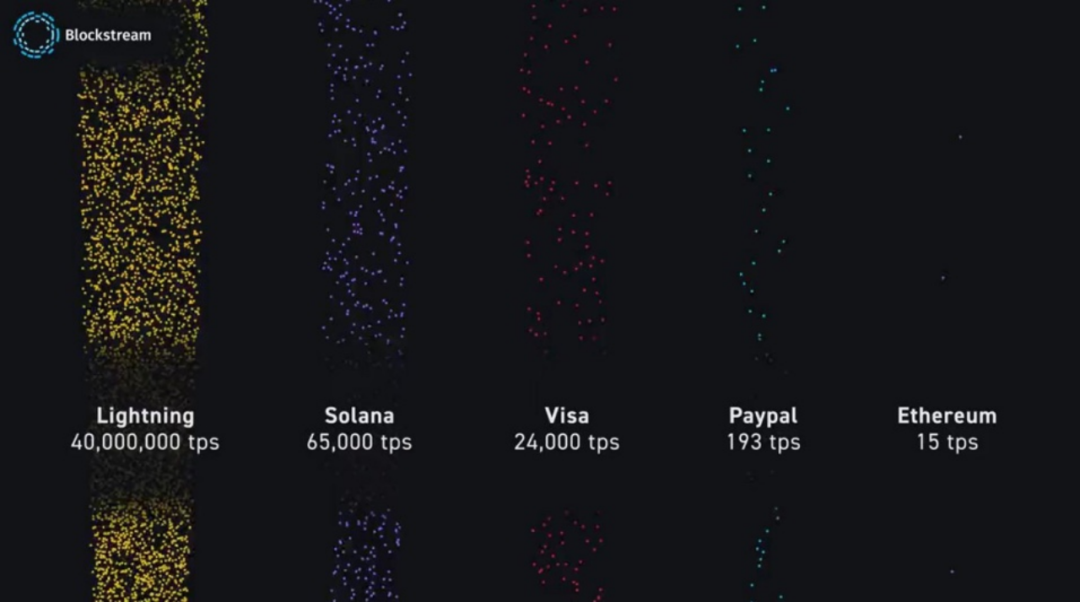
Comparison of Lightning Network TPS with Solana and others (Image Source: Blockstream)
II. Performance of the Nostr Protocol
- Data Performance: According to data from nostr.io, as of February 5, 2023, the number of Nostr public keys was 500,463, with 289 relays and over 1.21 million events. Nostr initially defined three different event types in NIP 01: 0: Sending metadata about users, such as usernames, images, profiles, etc.; 1: Sending text messages and basic content; 2: Recommending relay servers for people to connect with event creators.
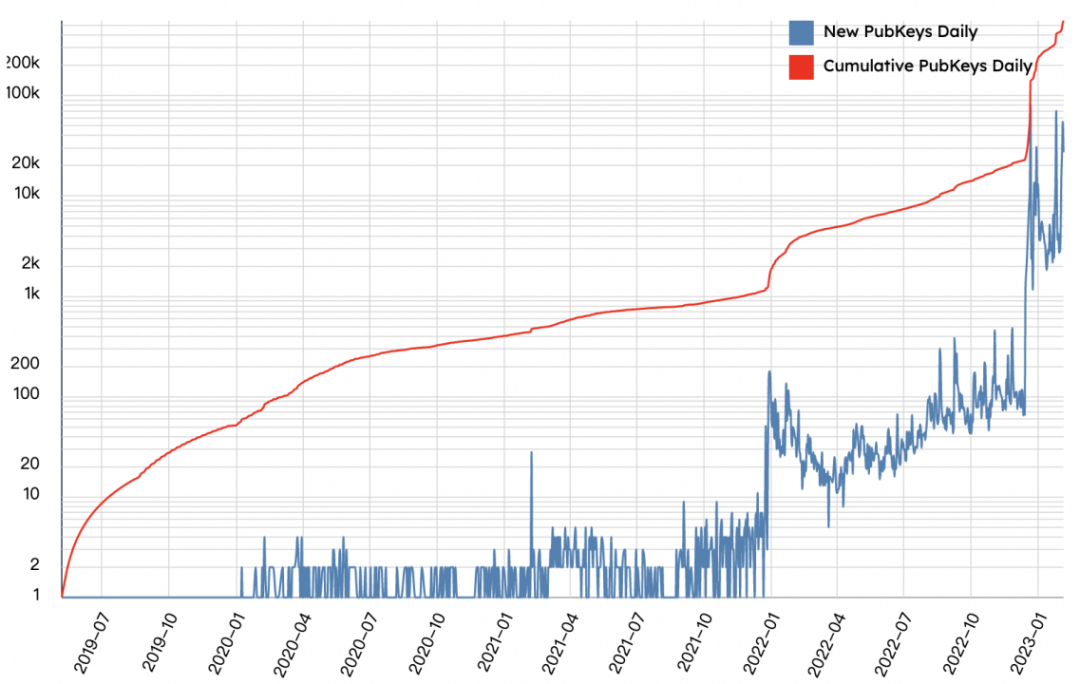
Number of Nostr Public Keys (Data Source: nostr.io)
- Ecological Applications: The decentralized Twitter is currently the largest use case for Nostr, but its applications extend far beyond social products. Now, Nostr has established applications similar to Telegram like Anigma.io, alternatives to Reddit like novote, end-to-end encrypted text-sharing tools like Sendtr, online chess mini-games like Jeste, and more.

Comparison of Nostr Ecological Application Functions, Data Source: https://github.com/nostr-protocol/nostr
III. Differences Between the Nostr Protocol and Other Decentralized Social Protocols
Currently, some representative social protocols have emerged, including the federated network social protocol ActivityPub, Matrix; peer-to-peer social network protocols Secure Scuttlebutt, Lens Protocol, etc. Some believe that Nostr is more like Bitcoin, while Farcaster is more like Ethereum. Both aim to create decentralized social networks but differ in their implementation paths. The following is a comparison of the two:
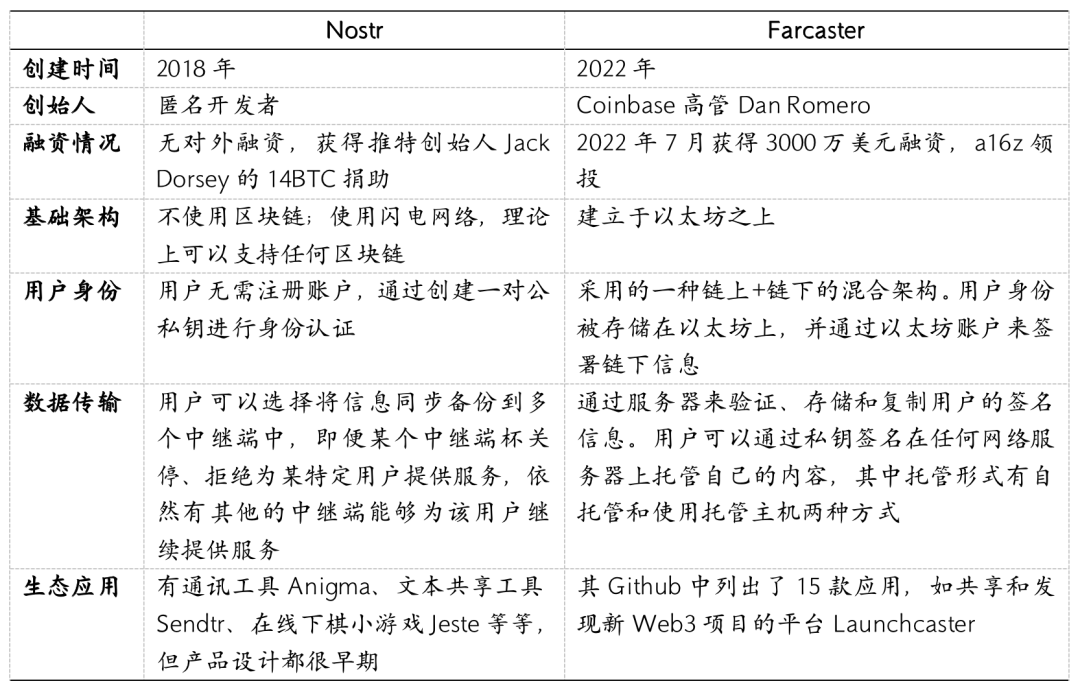
Comparison of Nostr and Farcaster Basic Information
In comparison, Nostr is a very lightweight open protocol that adheres to a simple and neutral style, seemingly following the spirit of cypherpunk and Bitcoin, while Farcaster follows a more traditional startup tech company model. For developers, the simplicity of the protocol allows for quick consensus on open standards, placing all complexity on the client side, enabling rapid development iterations on client programs that are compatible with any available relays. Currently, Nostr's Telegram community has attracted over 6,000 members for lively discussions.
IV. Performance and Potential of Damus in the Nostr Ecosystem
In December 2022, Twitter founder Jack donated 14.17 BTC (approximately $245,000) to further fund the development of Nostr. On February 1, 2023, Jack announced the listing of Damus on the Apple App Store and Google Play, which instantly ignited interest, with nearly 100,000 new users within half an hour.
In my opinion, besides Jack's celebrity effect, the reason for Damus's breakout lies in the fact that, previously, whether at the decentralized protocol layer or application layer, new projects emerged, but due to the protocol layer being far from end users, it was not conducive to understanding, and there were not many applications with scale effects. Therefore, most people remained in a state of both anticipation and confusion regarding how decentralized social networking could be realized. The emergence of the mobile decentralized product Damus has thus materialized everyone's expectations.
1. Product Overview
Damus is an application based on the decentralized social protocol Nostr, positioned as "The social network you control," meaning users can control their own social networks, reflecting the core spirit emphasized by Web 3.0. In terms of product functionality, users can publish content in the square, send private messages, and make payments via the Lightning Network.
2. Product Features
a) No Registration Required: Users only need to fill in a nickname to generate a pair of public and private keys without using email or other registration methods. Users can then search for and follow friends based on their public keys.
b) User Ownership: With censorship-resistant characteristics, users can control their own data.
c) Encrypted Conversations: End-to-end private message transmission.
d) No Servers Required: Messages are distributed through distributed relays, requiring no infrastructure to run and having no single point of failure. Each post has a unique Note ID, which can be copied and directly entered on the search page.
e) Programmable: Allows for easy integration of bots.
f) Income Generation: Users can use Bitcoin Lightning Network functionality for payments and tips. Currently supported Lightning payment platforms include Strike, Cash App, Muun, Blue Wallet, Wallet of Satoshi, Zebedee, Zeus LN, LNLink, Phoenix, Breez, Bitcoin Beach, Blixt Wallet, River.
3. Product Experience
Functionally, Damus does not break much new ground in user imagination and is still a primary version in urgent need of optimization. Many features remain incomplete, such as the inability to format the content editing page, the inability to cancel likes, and the inability to delete published content. However, it has a low entry barrier and is available on mobile, allowing users to easily download and use it. Concepts such as user ownership, encrypted conversations, and Lightning payments promoted by Damus have sparked discussions among users and the crypto community.
4. Development Potential
Whether it was the Lens Protocol developed by the founder of Aave or the currently supported Damus by Jack, it seems that the explosive popularity of social products is inseparable from the "shouting" of influential people in the industry. However, due to users' established habits in using social products and the difficulty of migrating user data, most emerging social products are merely fleeting. Retaining users remains a significant challenge. Even though decentralized social networking is not an easy task, Damus has relatively smoothly completed its cold start and gained substantial attention. From the current posting content, Chinese users are very active, and they have spontaneously organized various communication communities.
V. Issues with the Nostr Protocol
1. Relay Incentive Issues
Although anyone can establish a relay, there are currently only over 200 public relays globally because building them has barriers; it requires good processing performance and network capabilities, as well as certain technical and operational skills. However, relays lack revenue, so how to attract more relays to join is a problem. If the infrastructure is built on a fragile "voluntarism" basis, it will be difficult to grow into a strong social network.
However, if there are incentives, it will face the dilemma that most incentives will gradually be controlled by a few people, making it impossible to form effective incentives and susceptible to attacks. Regarding the incentive issue for running relays, developers believe that we should not assume that relay operators will provide services for free; even without so-called "incentives," DHT nodes in a P2P network continue to operate.
Response from Nostr developers regarding relay operation incentives Source: https://github.com/nostr-protocol/nostr
2. Data Storage Issues
Currently, data is primarily stored on relays, but this is not permanent storage; once users change clients, the information is cleared. Relays lack incentives and do not have enough motivation to store user data, thus there is a possibility of relays actively or passively deleting data. In the future, Nostr may provide incentives for storage functions, ensuring decentralization and ease of use while making data more accessible.
VI. Prospects for Nostr's Development
Overall, Nostr is a very simple and highly interoperable protocol that presents the possibility of emerging from the intertwining of decentralized social protocols and the value transfer of freedom. The combination of clients and relays makes the publication and transmission of information more resistant to censorship, aligning with the core spirit advocated by Bitcoin. Additionally, the closer integration of Nostr and the Lightning Network provides the possibility for native integration of social applications with Bitcoin.
Perhaps what we need at this stage is not a replica of a Web2 application based on Nostr, but a finely designed infrastructure to solve the Lego block problem, allowing hidden super developers to build products that exceed imagination and have a strong Bitcoin core. Nostr has opened a window for decentralized social networking, and from now on, I believe large-scale protocols and applications will usher in new breakthroughs. Decentralized social networking is just beginning. Decentralized social networking will move forward relentlessly.
References
Nostr Github: https://github.com/nostr-protocol/nostr
https://www.btctimes.com/news/what-is-nostr-and-how-do-i-use-it
Discussing NOSTR and Censorship
https://coolshell.cn/articles/22367.html
What is Bitcoin Lightning Network tipping supported by Nostr, and how to use it for small payments?
https://www.qianba.com/news/p-438799.html
Damus: Randomly distributing small amounts of Bitcoin to users through the Bitcoin Lightning Network
https://www.chaincatcher.com/article/2086905
Nostr's ambition goes beyond replacing Twitter
https://www.chaincatcher.com/article/2086888
The New Year of Social Media: Principles and Key Management Issues of Nostr
https://mp.weixin.qq.com/s/PfvXWhiTQzLzSc7bi2WXBw
Try Nostr's first client Damus, a new Web3 social network recognized by Twitter's founder
https://www.8btc.com/article/6801252
Decentralized Social Protocols: Nostr to the Left, Farcaster to the Right
https://www.8btc.com/article/6801408
A Comparison of Decentralized Social Protocols Nostr and Farcaster
https://new.qq.com/rain/a/20221226A05A4F00





